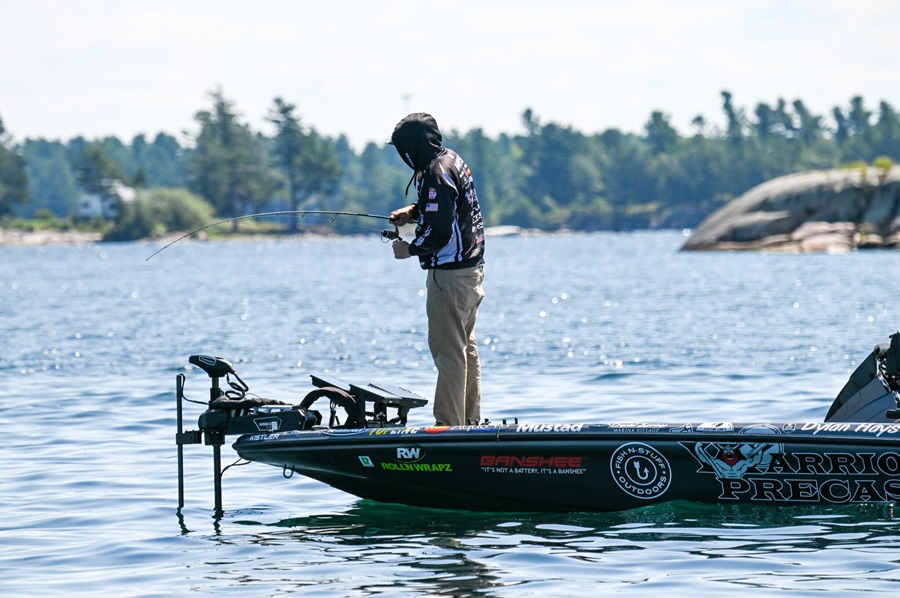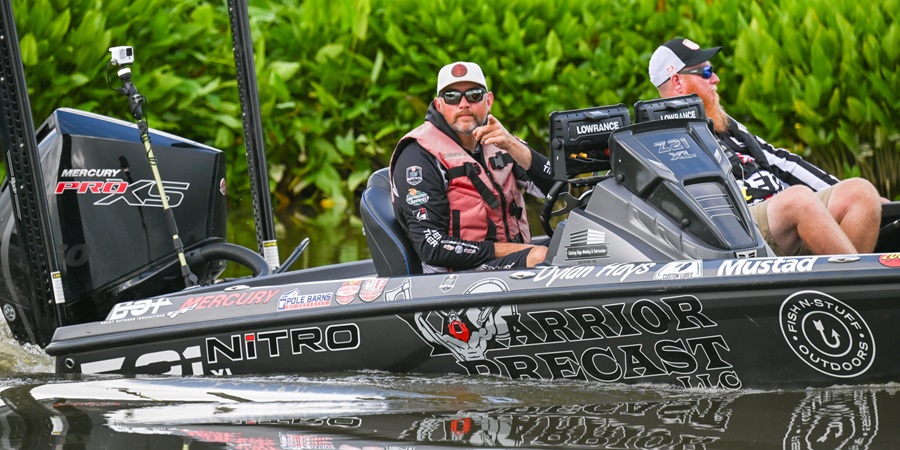
Swimbaits have become standard tools for bass fishing. Both tiny versions and massive baits are used all over the place and continue to catch plenty of bass each month of the year. Many versions of swimbaits come pre-rigged, while some have trebles attached. There are also a host of soft plastic swimbaits that require the right hook or jighead. Bass Pro Tour angler Dylan Hays uses all sorts of swimbaits and shares some insight into how he rigs a variety of different baits.
Rigging Finesse Boot Tail Swimbaits

Small finesse swimbaits like the Keitech Swing Impact FAT or the Zoom Z Swim that Hays uses are great for catching fish and can be used in many ways. They excel on a jighead but also work great on an Alabama Rig and are great when fishing offshore. Hays uses them often, especially when the fish chase baitfish away from the bank.
“A small swimbait on a ball head jighead is great, and I use them a lot, especially when fishing for spotted or smallmouth bass,” he said. “I’ll use a little tiny one under three inches and fish it on a spinning rod because, most of the time, it’s about trying to use finesse and get a bite. Normally, I’m going to be throwing it to suspended bass that are roaming or ‘floating’ in the water column, but they are also great for casting to groups of fish sitting on the end of a point or on top of brush.”
When fishing these small swimbaits, he likes the Mustad Ultrapoint Ball Jig Head, which comes in sizes from 1/8 to 5/8 and has many different hook sizes for each jighead weight.
“The great thing about those heads is they come in a gazillion sizes and hook options, so you can match the hook to any swimbait you are throwing,” he said. “They have a sharp hook, a 90-degree line tie, and a great keeper. That keeper is simple but efficient.”
For sizes, Hays varies based on the depth and where the fish are sitting in the water column. “The majority of the time, I start with a ¼-ounce. That’s my most common head, followed by a 3/16-ounce,” he said. “If the fish are higher in the water column, I go with a 1/8, and I’ll go up to a ½-ounce head if they are way down there. For hook sizes, I usually go with a 2/O or 3/O unless I’m using a little bitty swimbait and need a 1/O.”
Hays added that this jighead works great for fishing small swimbaits and shaking a minnow with the mid-strolling technique. “That’s how I caught all my fish this year on Toledo Bend when we started the year,” he said. “It’s a good dual-purpose head that works for straight tail and paddle tail baits.”
Rigs for Bigger Swimbaits

When using a larger swimbait, Hays prefers two different hooks and jigheads, primarily depending on where he’s fishing them. A weighted swimbait hook with a spring is his favorite when fishing around vegetation.
“I like a weighted swimbait hook for all of my hollow belly baits,” he said. “I like the Mustad Power Lock Plus Spring Keeper Weighted Hook, and the spring is great for securing your bait. It’s what I like for all my hollow bellies, but it also works for any solid soft swimbait.”
Hays matches the hook size to the size of the bait and will use a variety of weights, including the smallest they offer: 1/16-ounce. “That light head is great for buzzing a Zoom Swimmin Fluke over grass,” he said.
When fishing offshore with larger hollow-belly swimbaits or paddle-tail baits, Hays often uses an open hook, such as the Mustad TitanX A-Tak swim jig head.
“It’s a heavy-duty hook and typically what I go with when fishing for bigger fish,” he said. “I fish it on baitcast gear and 15- or even 20-pound line for largemouth with a 5- or 6-inch hollow belly swimbait.”
He generally fishes offshore and says a large swimbait on a jighead can be a great way to catch these bass. “I like the ½-ounce version and fish it over brush or on ledges and shell bars,” he said. “It’s a stout hook, and they have some great-looking colors to match any swimbait you want to fish.”
There are many ways to fish soft plastic swimbaits, and one of the most important is picking the right hook or jighead for the job. Bass Pro Tour angler Dylan Hays keeps it pretty simple and uses a dedicated hook size and weight, depending on the situation.


 Advertising
Advertising